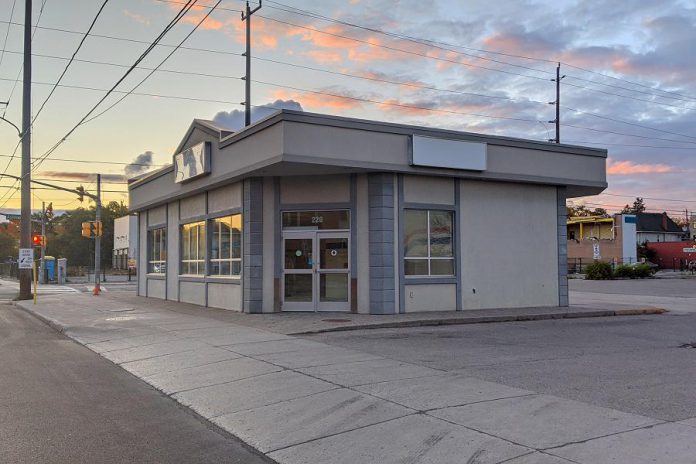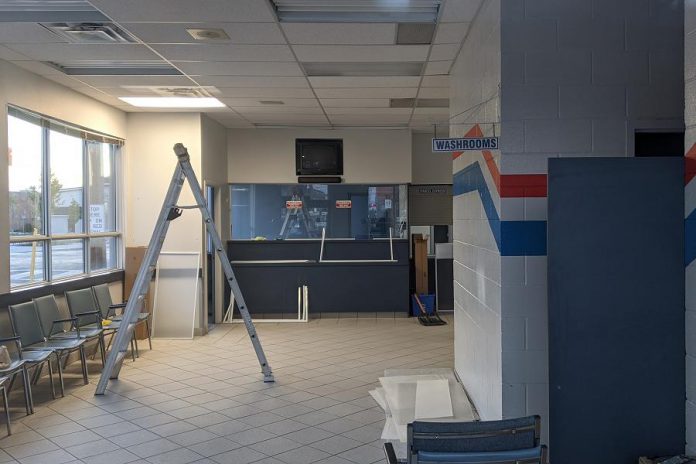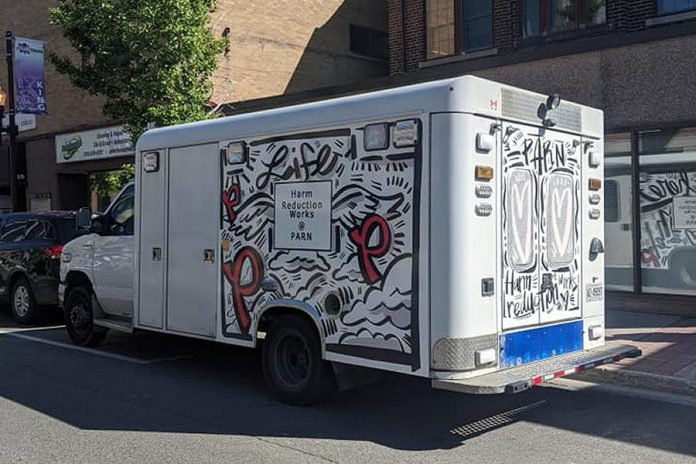
A major step in a collaborative bid to bring a Consumption Treatment Services (CTS) site to Peterborough has been realized with the establishment of a new ‘Opioid Response Hub’.
The announcement was made on Friday (October 2) in a virtual media conference hosted by Peterborough Drug Strategy and attended by Peterborough medical officer of health Dr. Rosana Salvaterra, PARN executive director Charles Shamess, Four Counties Addiction Services Team (FourCAST) executive director Donna Rogers, Peterborough Drug Strategy chair Peter Williams, Peterborough Police Services deputy chief Tim Farquharson, and others.
The former Greyhound bus terminal at 220 Simcoe Street (at Aylmer Street North) is the hub’s location, providing a new home for Harm Reduction Program services offered by PARN and the soon-to-be-launched Mobile Strategic Overdose Response Team (MSORT). In conjunction with the move, Harm Reduction Program services will be provided under the name Harm Reduction Works.
With the hub’s permanent space secured, the partner agencies that have been working to bring a CTS site to Peterborough will submit an application to the Ontario government. Those agencies — PARN, FourCAST, the Four Counties Addiction Services Team and Peterborough Public Health among them — are nearing the completion of that application and hope to submit it within the coming weeks.
A CTS will provide onsite services as well as defined pathways to addiction treatment services, primary care, mental health, housing and other social supports. A CTS will provide people who use injection drugs a safe, hygienic space to use those drugs under the supervision of health professionals in order to prevent opioid poisoning deaths. In addition, it house on-site services as well as pathways to addiction treatment services, primary care, mental health services, housing and other social supports.
During a year that has seen the number of opioid overdose-related deaths in Peterborough already surpass the total for all of 2019, Friday’s announcement of the hub is seen as a crucial development in what has been a lengthy effort to see a CTS established in the city.

PARN’s Harm Reduction Program will move out of its current space at 541 Water Street and make the transition to the hub starting next week. Its services include providing sterile drug-use equipment to prevent the transmission of blood-borne viruses as distributing Naloxone to those at risk of an overdose. MSORT, meanwhile, will use the hub as a home base in its effort to connect those who have overdosed but choose not to go to the hospital with services that can help them.
“We’ve distributed more Naloxone during the pandemic than during previous periods but the poisoned drug supply has killed 34 of our friends and neighbours,” said an emotional Charles Shamess, executive director of PARN.
“We’re very grateful to be working with a property owner (Kevin MacDonald) who understands the importance of harm reduction and who knows a consumption and treatment service will save lives. To date, the federal government has approved 40 supervised consumption sites that have been visited more than two million times, reversed nearly 16,000 overdoses without a single death and made more than 74,000 referrals to health and social services.”
PARN, added Shamess, will “be the lead” on the application for grant money for a CTS but stressed a collaboration involving a number of partners will be key to any success. If and when approval comes, he says renovations to the hub site will have to be done with CTS occupying the majority of the space.
Donna Rogers, the executive director of FourCAST, said “Working together, out of the same space, is our ideal outcome.”
“People who want to make changes to their opioid use need services and there are never enough locally or provincially to meet the demand. We believe we can multiply treatment options by working together. We desperately want to be participating in solutions that reduce and ultimately eliminate opioid-related deaths. This hub model is right for this community right now.”
Peterborough Drug Strategy chair Peter Williams also addressed the media on the hub’s formation, providing a history of the collaborative effort that has led to this development.
“In December it will be three years that we’ve been having those conversations (about the need for a CTS in Peterborough),” noted Williams.
“We’ve faced numerous challenges, including finding the appropriate space and a willing landlord. This location will allow us to bring a CTS site to Peterborough…to submit an application that checks all the boxes of the federal and provincial guidelines.”
Williams said a survey conducted by the Peterborough Drug Strategy in November 2019 indicated that 74 per cent of more than 1,600 participants agreed a CTS site will benefit the community. Participants ranked the reduction of injuries and deaths from drug overdose and poisonings, prevention of blood-borne infections, and fewer publicly discarded needles and drug litter as key benefits of providing a CTS.
Williams added a separate survey of injection drug users showed 91 per cent would access a CTS site in downtown Peterborough if it was provided.
As for the long road taken to get to this point — and a sizable step closer to a CTS site — Williams said “We signed up for frustrating,” adding “Collaboration, if done right, is supposed to be hard and time consuming and challenging and frustrating.”
“That’s how you know you’re on the right track. We are all very relieved to be at this stage but this is not a finish line. It’s a new start line. We can’t afford to let frustration overtake us. We’ve still got a lot of work to do and we’re up for it.”
Peterborough Police Services deputy chief Tim Farquharson, a vocal and very passionate advocate for a CTS site, expressed his clear relief over the hub’s formation and its importance in terms of the CTS application process.

“A lot of cities haven’t accepted the fact of what needs to be done to move forward but we have,” Farquharson said.
“When I was on the road, we had nothing to help people with addictions. We gave them a 1-800 number and then moved on to the next call. Now we’ll have an outreach team (MSORT) that goes out there. We didn’t have PARN in the year 2000. We were finding needles all over the city. There are still challenges with that but it’s a fraction of what we dealt with before.
“This hasn’t been smooth — there have been a lot of challenges — but look where we are now. We’re leading and we have the possibility to reverse the (opioid overdose fatality) trend.”
Shamess notes that, should Peterborough’s CTS application be successful, renovations would need to be done to the hub site to accommodate it alongside Harm Reduction Program services and base operations for MSORT.
“Along with a CTS, we would have other treatment available, from FourCAST and Canadian Mental Health, and potentially EMS might be involved as well,” Shamess said. “A whole different staffing would come with CTS.”
Additional consultations will be held with stakeholders in the area of the proposed site in the coming weeks. For more information and updates, visit peterboroughdrugstrategy.com/cts/get-involved/.


























